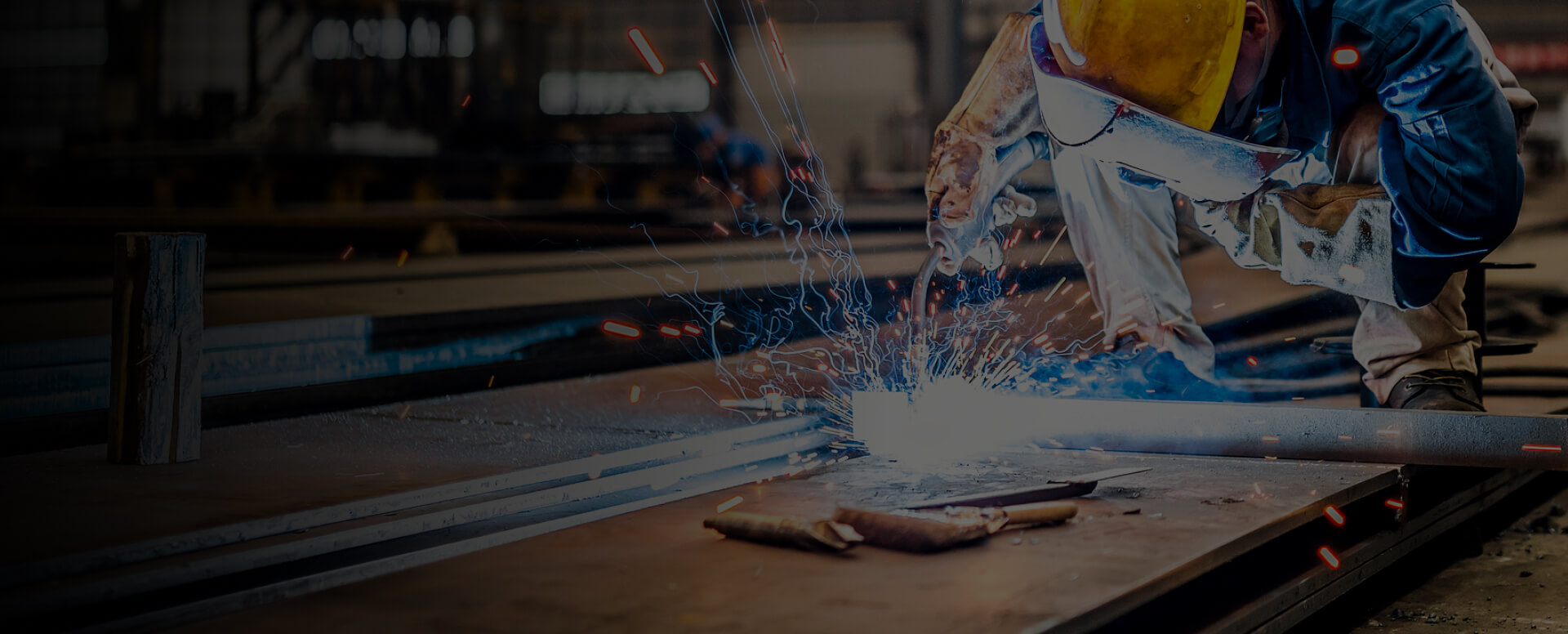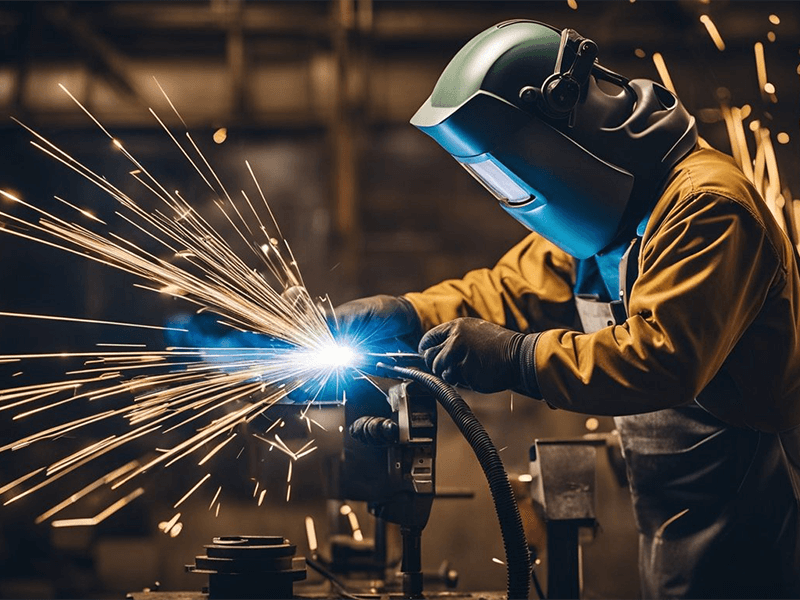
The five key welding parameters are current (40-200 amps), voltage (18-29 volts), travel speed (8-18 inches per minute), electrode type (e.g. E6013, E7018), and shielding gas mixture (e.g. 75% argon, 25% CO2). Table of Contents Switch Current Voltage Travel Speed Electrode Type and Size Shielding Gas Current Current Current is one of the main aspects that determine welding, as it directly affects the heat input and weld quality. Different materials require specific currents because only this will produce the best weld results, the best in terms of strength and appearance. For example, welding stainless steel with a thickness of 0.1 mm or less may require a current as low as 40 or 50 or even as high as 70 amps to avoid burning through and maintain a sharp edge with a clean, solid joint. At the same time, thicker steels may require 120-200 amps to weld, which means that low currents may not provide the required penetration to ensure a solid joint with high penetration. As for the percentage factor, the current depends largely on what is being welded, the type of metal used, and its thickness. A common metric for determining the amperage is about 11 amps per 0.001 inch of metal. When dealing with two metals of equal thickness: steel and aluminum, the latter will usually require a higher current due to the higher thermal conductivity of aluminum. At the same time, the penetration depth per unit current may also be different; when the two metals are exactly the same thickness, the penetration depth of aluminum may be lower. At the same time, the current setting is also a major consideration, as it is usually related to the welding speed. In large-scale production industries such as automobiles and shipbuilding, the choice of current can greatly simplify the welding process and thus increase productivity. In this case, the speed of operation is crucial, as any production process requires the fastest speed. Especially when welding multiple passes, speed may also affect the final quality and increase costs. For smaller applications, current fluctuations in the range of 30 to 150 A, which is a characteristic of common multi-process welding machines, are sufficient. For thin metal materials, these currents can achieve almost zero penetration levels, which are sufficient for more delicate applications. At the same time, the latter is also suitable for the construction industry when thicker materials need to be filled, such as crucibles on ladles, metal garden gates, or repairing damaged solid tool centers. The effect of MIG TIG welding voltage on arc characteristics, especially the width and appearance of the weld bead, is significant. Therefore, proper management of voltage settings is essential to ensure a smooth, aesthetically pleasing finish on all types of welds. For example, increasing the voltage slightly can achieve a longer, wider arc, which may be necessary to apply fillet welds to hard-to-reach corners and sections of components. When welding MIG on steel, the voltage may vary around 18-22 volts for thin materials less than 1/8 inch thick. Conversely, it may rise to 29 volts for thicker materials to ensure adequate heat penetration and create a strong connection. In addition, when working on certain types of projects, especially those that require a high degree of aesthetics in the finished product, such as a custom motorcycle frame or a fine steel sculpture, it is necessary to adjust the voltage to obtain a more precisely sized weld bead. Such adjustments can greatly facilitate post-weld cleanup; reduce the amount of beading effect; and enhance the weld appearance of the weld bead, thereby improving the aesthetics of the finished product. Finally, voltage adjustments can directly reduce spatter, which is a common problem in welding. Especially for most applications, lower voltage is considered acceptable because it reduces spatter; the automotive repair industry is one of the industries where spatter can damage many parts. This is because spatter can damage sensitive parts and welders must spend a lot of extra time grinding it off if shielding hoods/boxes are not used. This increases production costs, among other things. Therefore, welders working in this field should aim to use lower voltages to create low spatter connections. DIY welders or home welders also need to consider voltage carefully because portable welders have a narrower operating voltage range. For example, they rarely require welding voltages above 110-140 volts, so they are limited to welding very thin materials. At the same time, they are generally suitable for a wide variety of steel DIY applications, from wheel manufacturing to swing sets, and are cost-effective.
Travel speed Travel speed in welding refers to the speed at which the welder moves the welding gun along the length of the workpiece. The length of this section of the welder's travel directly affects the heat input to the workpiece, which in turn affects the weld penetration and weld bead appearance. While a key welding parameter, travel speed is also a particularly important variable that welders must learn to control effectively. This phenomenon is common in pipe welding, for example. The welder must control the travel speed to ensure a high-quality, uniform weld bead along the length of the pipe. In residential plumbing, the pipe being welded is relatively thin. To avoid warping of the pipe, the travel speed should be 12-18 inches per minute. In fact, this speed is slow enough to ensure proper fusion, but fast enough to prevent heat buildup. Another example where travel speed is critical is in the body of an automobile. When working with thin sheet metal, heat input must be precisely controlled. The travel speed should be slow enough to avoid excessive heat input, which can cause warping and burn-through. On the other hand, the travel speed should also be fast enough to ensure proper fusion. Typically, in this case, an inappropriate travel speed is around 8-10 inches per minute. Metal hobbyists may work on small projects such as making metal benches or garden gates IT projects. Travel speed is also important because it affects the quality of the project. In a project where handrails are attached to stair treads at a speed of 5-6 inches per minute, reducing the travel speed is a key factor. Finally, in ammonia, the travel speed must be synchronized with the production timeline. If the speed is too slow, space and equipment will be idle and labor costs will increase.
Electrode Type and SizeOne of the major factors in welding is the type and size of welding rod. It has an impact on ease of use, weld quality, and weld characteristics. The best electrode selection depends on the material being welded, the expected strength development, and the weld position. An example in electrode welding is the general choice of E6013 electrode, which is widely used on mild steel. It is the best electrode for welding smooth welds while being able to effectively and easily remove slag, making it a good choice for novices. The best range of electrode diameters is 1/16 inch for welding thin plates and 1/4 inch for welding thick plates. The 1/8 inch E6013 electrode is able to accomplish most general maintenance and repair tasks and provides the best balance between penetration depth and ease of welding. If stainless steel is to be welded, E308L electrodes are more preferred because of their corrosion resistance. It is available in sizes that best suit the corresponding material thickness, with the most convenient electrode size being no more than 1/16 inch for plates no thinner than 0.048 inch, with minimal warping and excellent surface finish and quality. Building frames or heavy equipment, equipment that workers are repairing, or production plates should be welded with E7018 electrodes, which are best suited to achieve high-strength welds with a huge margin of tensile strength. They are generally available in thicknesses between 1/16 inch and 5/32 inch, with maximum penetration depth on thick materials, a range that is critical for structural integrity. Electrodes with an average diameter of about 1/8 inch, such as E6011, can withstand AC or DC currents and multi-position welding, such as vertical upward welding and overhead welding. If one's home welding tasks are to produce a sheet metal table or repair garden tools, then the best thing to do is to purchase a welding rod. The size and depth of these electrodes are perfectly matched to different thicknesses and metal types, helping to clearly distinguish the distant depth of the weld.
Shielding Gas One of the main aspects of the welding process is the type of gas used, as it affects arc stability, the resulting weld, and the level of atmospheric contaminants. Of course, the choice depends mainly on two general factors: the type of material to be welded (some gases are better suited to specific types of metals) and the quality of the weld required. A common choice for MIG welding of mild steel is a mixture of 75% argon and 25% CO2. This mixture is reasonably priced, comfortable to operate, and produces smooth, high-quality welds with minimal spatter. When welding with greater demands for cleanliness and appearance, such as car body or metal art cutting, a mixture of 95% argon and 5% CO2 is considered more advantageous. However, the latter is more expensive, although it is not recommended to increase the argon percentage above 95% because the arc becomes very unstable. Even a small amount of CO2 makes the arc more stable, which means that some additional cleaning is still required afterwards. TIG welding is suitable for all materials, including aluminum and stainless steel, where 100% argon is used due to its inertness and very stable arc formation. This produces corrosion-resistant welds of excellent quality, high strength and precise control. createClass applications, such as welding aerospace components or all-stainless steel cutlery. This gas is also quite cheap and is almost universally used. A controversial option is pure CO2, which provides additional penetration at a very low cost of 30 rubles per liter. As for the disadvantages of CO2, spatter becomes more pronounced and the L*A*P*S* values of the process deteriorate, in addition to reduced cleanliness. This means that, while this gas may be nominally cheaper after accounting for all conceivable costs, the savings will be similar to or zero as is commonly done with the CO2 refining process for magnesium. Finally, when the weld thickness is relatively modest and the highest possible quality is required, and cost is not an issue, even small amounts of argon can be used. A third common gas is helium, because it improves penetration. For example, welding one-inch thick non-ferrous metal plates.
Related Articles

MIG Vs. FCAW Welding: Key Differences & Application Scenarios
MIG welding requires external gas and is cleaner, ideal for thin materials. FCAW is versatile, self-shielded, better for thick materials and outdoor use, faster, and less sensitive to surface contaminants. Table of Contents Toggle Electrode TypeShielding GasUsability and ApplicationPerformance in Di

